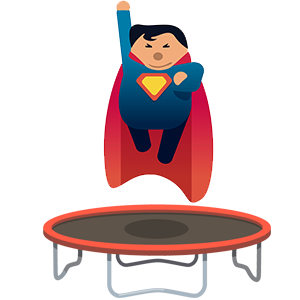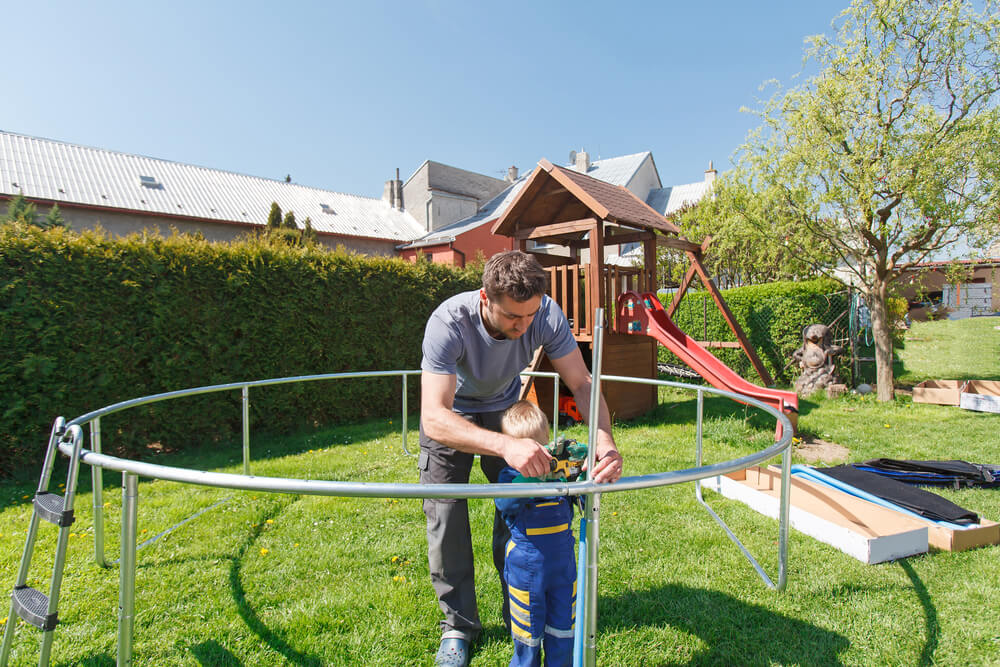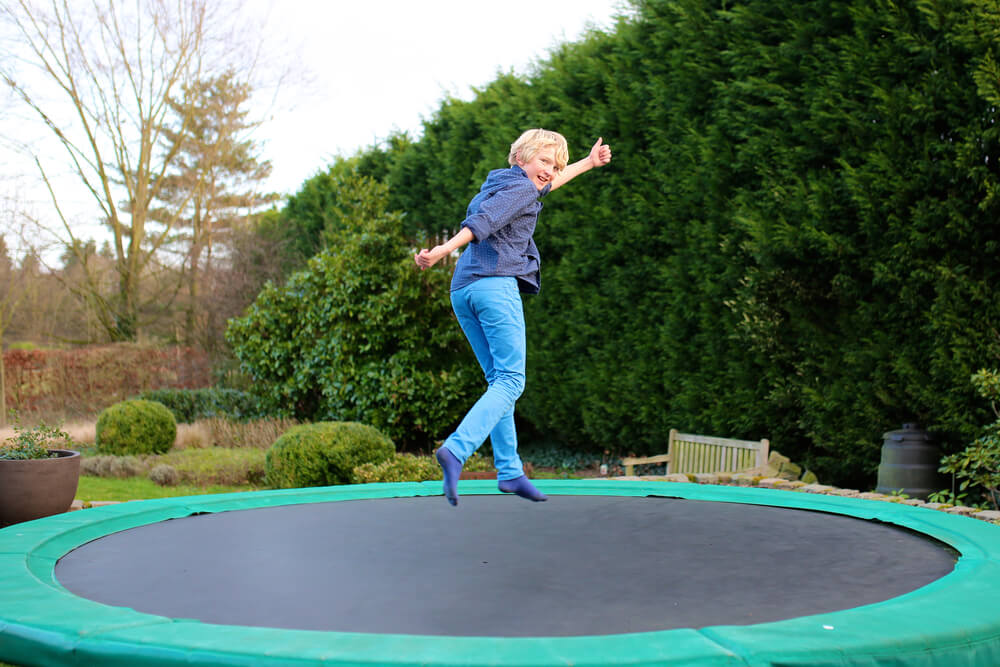Most trampolines have been designed to accommodate not more than 200 pounds.
Most trampolines for kids may state that adults can also use them. However, this may be incorrect according to the manufacturer’s specs. Each trampoline comes with a maximum weight tolerance that you should not exceed.
While trampolines may not quickly break down if the users exceed the indicated weight, it increases the risk of prematurely reducing the equipment’s lifespan.
A trampoline’s weight limit is based on the springs’ load capacity rating or the support rods. When those limits are exceeded, the trampoline may break.
Different Trampolines Have Varying Weight Limits
Most outdoor trampolines for children can hold only 200 pounds or less. On the other hand, toddler trampolines can only hold 50 pounds or below.
There’s a new type of indoor trampolines known as “Parent/Child trampolines.” Most of these can hold 150 pounds or less. That means an adult should weigh 120 pounds or less to comfortably use such products.
On the other hand, an outdoor adult trampoline often supports anywhere between 400 and 750 pounds. If three adults use the trampoline and exceed its weight, risks of failure may be imminent.
Note that if the trampoline fails because you placed excessive weight on it, the warranty may be void.
Why Is It Important to Know the Weight Limit on Your Trampoline?
Trampolines are becoming increasingly popular in nearly all households because they are a source of endless fun for kids and adults alike.
However, it’s important to know a trampoline’s weight limit to prevent accidents from happening when people start to jump on it.
After purchasing a trampoline, you’ll notice that the weight limit is indicated. But you can’t assume the indicated weight limit is accurate. Safety is paramount, which is why it’s best to conduct your own research as well.
The weight a trampoline can withstand is paramount to help keep you and other users safe. If the trampoline’s weight is exceeded, the equipment’s spring may break. Besides, the mat can tear down unexpectedly leading to a bad accident.
Therefore, for the sake of your safety and proper functioning of the trampoline, it’s best to know how much weight the trampoline can bear.
What Factors Determine the Weight Limit of a Trampoline?
Several factors determine the trampoline’s weight. These include:
Materials
A trampoline comprises three major components: Springs, frame, and jumping pad.
Springs
The springs help to produce the bouncing motion and are an important factor that determines the weight limit of a trampoline. The springs range, which is between 3.5 and 9 inches, is designed to support the use of trampolines. In other words, they contribute to the strength of trampolines.
Jumping Pad
The jumping pad often consists of waterproof canvas or woven polypropylene. Polypropylene is smooth, flexible, and also solid when layered.
The weight limit is dependent on the material type used to make the jumping pad and the material’s weaving style. For example, heavyweight jumping pads often have more stitching rows whereas lightweight pads have fewer ones.
Frame
The role played by the frame is essential when it comes to the trampoline’s structural integrity. Heavyweight trampolines come with thick gauge steel frames that offer more stability than lightweight ones.
Size
Generally, the trampoline’s weight limit is directly proportional to its size. The bigger the trampoline, the higher the weight limit.
A toddler trampoline is typically 8 to 10 feet in height with a weight of approximately 100 pounds. It has a weight limit of 75 to 150 pounds.
Due to this weight limit, toddler trampolines must only be used by kids aged between 3 and 10 years. A toddler trampoline suits this age group because it’s lower and has safety handrails. This trampoline type can fit in a small area within the backyard.
A 12-foot trampoline can withstand between 250 and 300 pounds. On the other hand, a 14-foot trampoline can bear a weight of between 250 and 350 pounds. A trampoline of 15 to 16 feet can bear anywhere between 250 and 450 pounds. Due to their high weight limits, these trampolines are suitable for adults.
Design and Style
A trampoline’s design often affects its weight limit. That said, rectangular trampolines have a weight limit of up to 450 pounds, but round ones can bear up to 400 pounds.
Rectangular and hexagonal trampolines have been designed to ensure less pressure is exerted on the springs. As it turns out, the springs on these trampolines are distributed in a way that makes them work independently rather than simultaneously.
And that depends on which section of the trampoline is in use. It’s for this reason that rectangular trampolines are created to withstand more weight.
However, circular and octagonal trampolines tend to put full weight on the springs on each bounce independent of the spring’s location.
How Much Weight Can a 6ft Trampoline Hold?
88 to 132 pounds
A 6-foot trampoline can support 88 to 132 pounds.
Most importantly, 6-foot trampolines are ideal for kids aged between 3 years and 8 years.
How Much Weight Can an 8ft Trampoline Hold?
110 to 220 pounds
An 8-foot trampoline may withstand up to 110 to 220 pounds.
You may be wondering if the trampolines are of the same size, why a wide range of the weight limit they can support?
Well, the weight range is because while trampolines in this category are of the same size, their mats are made of different materials.
That means you should always consider the material of the jumping pad (mat) when purchasing a trampoline.
How Much Weight Can a 10 Ft Trampoline Hold?
165 to 264 pounds
A 10-foot trampoline has a weight limit ranging from 165 to 264 pounds. Like in the case of 8-foot trampolines, the variation in weight limit depends mostly on the mat’s material type.
Also, the weight limit of a 10-foot trampoline is slightly above the 8-foot one. That means it’s still good for younger kids.
How Much Weight Can a 12 Ft Trampoline Hold?
250-300 pounds
The weight limit of a 12-foot trampoline lies between 250 and 300 pounds. Since it’s spacious enough, it’s suitable for both kids and adults.
However, consider the trampoline’s shape, as well. Round-shaped trampolines may only bear up to 200 pounds and squared ones may accommodate up to 300 pounds.
What Happens If You Exceed The Weight Limit On a Trampoline?
The short answer is nothing really happens if you exceed the state limit by a couple of pounds.
Most average sized trampolines have a weight limit of 300 pounds. This may sound like a lot.
However, keep in mind that the average adult male in the United States weighs approximately 195 pounds. Besides, the weight of an average 10 to 11-year-old is about 90 pounds.
So, when a father and his son are jumping on a medium-sized trampoline, they are almost testing the unit’s outer limits.
Generally, going over the labeled weight limit may not cause any dramatic results. Most companies often undershoot the weight capacities in favor of the user’s health.
Accidents that may arise because of faulty trampoline weight may hurt the brand’s reputation. Therefore, it’s in the brand’s best interest to offer you a slightly safer value.
For example, most users of the 15-foot Skywalker Trampoline have reported not experiencing any issues after exceeding the indicated weight limit of 200 pounds.
What Can Happen If You Overload the Trampoline’s Weight Capacity?
If you do something to stress test the trampoline’s weight capacity, such as bouncing with double or triple the recommended weight, the consequences can be pretty hazardous.
These pieces of equipment are tightly bound with numerous sharp and hard components, including the springs, frame, and mat. Therefore, if you exceed the trampoline weight by double the recommended weight, something is likely to give in.
It may only take one spring to be jarred loose and you’ll be helpless. If a spring doesn’t get loose, the mat’s fabric may tear, letting you fall beneath it (we pray there won’t be a stone on the ground).
We don’t mean to scare you, but it’s a good idea to stay with the trampoline’s indicated weight capacity.
The Takeaway
Weight is an essential consideration when choosing any type of trampoline. You may need to know the age and weight of whoever will use the trampoline. If you want a trampoline that can support more weight, it’s best to go for medium to full-sized trampolines (those with a weight limit of up to (300 to 400+).
If you and your kid decide to bounce on the trampoline at the same time and it tips the equipment’s weight limit by say, 10 pounds, you don’t have to worry about it. Some common sense applies with these pieces of equipment, especially regarding human safety.
The manufacturer has indicated the weight limit for your safety. It’s up to you to decide how closely you’d like to follow that limit.
Generally, it’s better to keep things on the safe side. Do you plan to have adults jump often or have the entire family bounce at the same time? Then you may want to invest in a trampoline with a bigger weight limit. This will certainly be less risky, less stressful, and danger-free for everyone.







